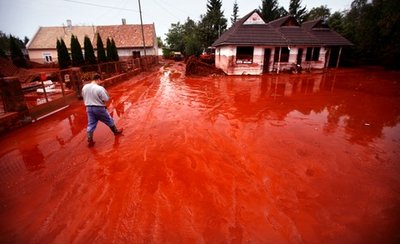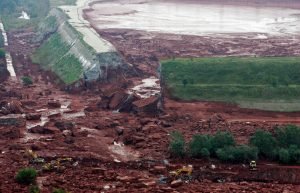Earlier this month, villages in the European country of Hungary were flooded with bright red toxic sludge from a nearby industrial facility, and environmentalists warned there are other lethal accidents waiting to happen across the region.
 The massive flood of caustic red sludge in Hungary has killed nine people, displaced hundreds and damaged tens of millions of dollars in property. Above, a man trudges through the red sludge in Kolontar, Hungary.
The massive flood of caustic red sludge in Hungary has killed nine people, displaced hundreds and damaged tens of millions of dollars in property. Above, a man trudges through the red sludge in Kolontar, Hungary.
The massive flood of caustic red sludge in Hungary has killed nine people, displaced hundreds and damaged tens of millions of dollars in property. Above, a man trudges through the red sludge in Kolontar, Hungary.
Swathes of the Hungarian countryside resembled scenes in a science-fiction film with animals, people, cars and buildings covered with a bright red mud-like material after two million gallons of toxic industrial sludge surged from a cracked reservoir into several rural villages 100 miles southwest of the capital, Budapest.
Nine people were killed and hundreds suffered injuries -- including burns from the caustic waste. Hundreds of people were displaced from their homes and private property worth tens of millions of dollars was destroyed.
What was the red sludge?
The red mud-like industrial byproduct was being held in a containment pond owned by Magyar Aluminum Zrt., the Hungarian Aluminum Production and Trade Co.
The byproduct is produced when bauxite rocks are processed to make aluminum. Investigators believe cracks in the reservoir's walls led a portion of the wall to collapse, releasing a toxic torrent that swept cars off roads and measured eight-feet high in some areas.
The breach was repaired, but red mud still coats more acres of land and Hungary's environmental minister estimates the clean-up will take up to a year.
Farmland soil must be removed and replaced because the alkaline chemicals will stunt future growth. Furthermore, once the sludge dries, it can become toxic airborne dust and cause respiratory problems.
The collapse of a wall at the Magyar Aluminum Zrt. containment pond released a wave of the red sludge, which is a byproduct of the aluminum mining process.
Toxic materials entered major European river
Not only did the sludge poison miles of farmland, but it has also entered local water sources and spread to the Danube River, the second largest river in Europe. From Hungary, the Danube flows through Croatia, Serbia, Bulgaria, Romania, Moldova and Ukraine territory en route to the Black Sea.
Hungarian scientists sought to reduce the effects of the caustic alkaline red mud on water sources by adding acidic material and fertilizers. Relief efforts were successful; the Danube measures a pH of 9.8, higher than normal, but much less than the 13 pH level at the accident site.
The exact chemical composition of the waste material remains unknown; however, aluminum processing generally involves compounds that include heavy metals and cancer-causing carcinogens such as cadmium, cyanide and chromium. Residents and relief workers complain that the sludge causes burns and irritation of the eyes and throat.
More "accidents waiting to happen"
Officials warned that the dangerous conditions that caused the accident are not limited to the aluminum industry.
"There are accidents waiting to happen, and it is not only happening in Hungary but across the region," Zoltan Illes, Hungary's state secretary for the environment, told The New York Times.
"The lesson of the sludge disaster is what can happen if environmental rules and regulations are ignored in the pursuit of profits."
European Union law stipulates that the company or organization responsible for disasters pay for all clean-up costs and compensation to injured parties. MAL Rt. Alumina has been fined more than $100 million for water damage thus far.
An investigation is underway, and the operating manager of MAL Rt. was detained on suspicions of public endangerment.
"This is an unprecedented ecological catastrophe in Hungary," said Hungarian Prime Minister Viktor Orban. "Human error is more than likely. The wall (of the reservoir) did not disintegrate in a minute. This should have been detected."
Hungary's environmental minister blames the spill on corporate negligence and "weak" European Union regulations. The EU does not classify the mud as a toxic substance, thereby allowing the aluminum manufacturer to process the waste material itself. Prior to joining the EU in 2004, Hungary classified red mud as toxic and required more stringent de-contamination and containment.
Eco-disasters stem from industry and oil
Since the Industrial Revolution, a number of eco-disasters have threatened human health and greatly harmed the environment.
One of the worst eco-disasters happened in April 1986 at a Ukrainian government-owned nuclear plant called Chernobyl. A malfunction sent a massive plume of radioactive smoke over much of the former Soviet Union and Europe. Radioactive material infiltrated water systems, destroyed nearby land and caused 50 fatalities and an estimated 4,000 cancer-related deaths and illnesses.
The disaster site is covered in concrete, but the reactors that were not damaged by the explosions and fires remain in use today.
Nuclear and toxic chemical disasters have happened in the United States as well. In 1979, the Three Mile Island nuclear generator in Pennsylvania melted down releasing radioactive gases. At the same time, toxic industrial chemicals dumped from 1920 to 1950 were found to be causing cancer and birth defects at the Love Canal neighborhood in New York.
The most recent eco-disaster was this year's Deepwater Horizon explosion in the Gulf of Mexico -- the worst oil spill in U.S. history. Millions of barrels of crude oil poured into the ocean for almost three months, poisoning birds and marine life along hundreds of miles of coastline. Scientists believe it will take decades for the area to fully recover.
--Compiled by Katherine Stevens for NewsHour Extra

 The collapse of a wall at the Magyar Aluminum Zrt. containment pond released a wave of the red sludge, which is a byproduct of the aluminum mining process.
The collapse of a wall at the Magyar Aluminum Zrt. containment pond released a wave of the red sludge, which is a byproduct of the aluminum mining process.




